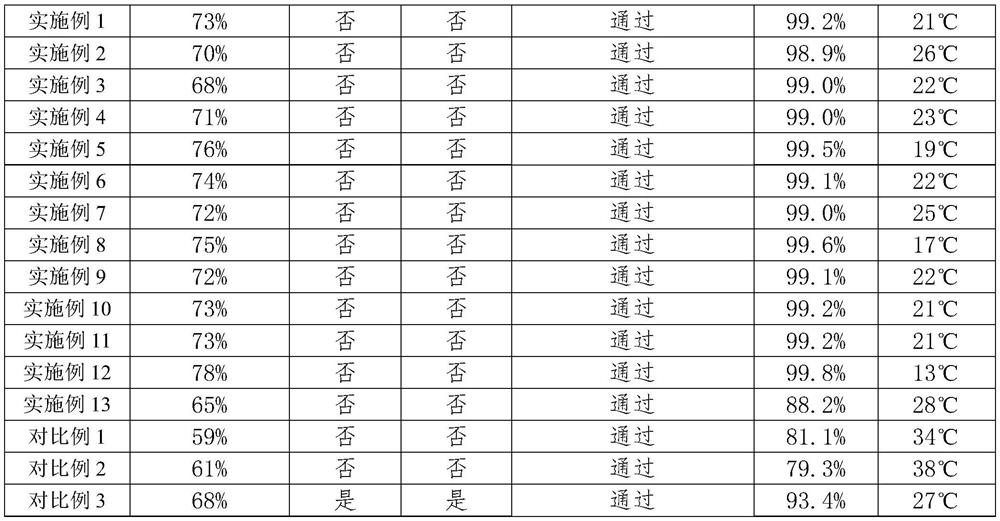Anti-overcharge low-temperature rate type negative pole piece and manufacturing method thereof, and lithium ion battery based on negative pole piece
A technology of a negative pole piece and a manufacturing method, which is applied in the field of anti-overcharge low-temperature rate type negative pole piece and its manufacturing field, can solve the problems of overcharging, unsatisfactory heat dissipation performance, poor heat dissipation performance, and temperature rise of lithium-ion batteries, and achieve reduction Battery internal resistance, avoiding the risk of thermal runaway, and reducing the effect of impedance
- Summary
- Abstract
- Description
- Claims
- Application Information
AI Technical Summary
Problems solved by technology
Method used
Image
Examples
Embodiment 1
[0062] Using ethanol as a solvent, the mass percentages of graphene, nano-TiN, nano-SiC, DDB, and dispersant (the composite mass ratio of titanate coupling agent and PVP in the dispersant is 1:1) are 3.6% and 3% respectively , 3%, 2.2%, and 0.2% are configured with compound additive slurry. The specific configuration process is as follows: first completely dissolve the dispersant in ethanol solvent, then add graphene, nano-TiN, nano-SiC, DDB powder sequentially or partly or completely, and ultrasonically 240min until the powder is uniformly dispersed to obtain a composite dispersant slurry.
[0063] A double planetary mixer is used to add negative electrode active materials, conductive agents, binders, and solvents, and the negative electrode slurry is prepared according to the conventional lithium ion battery homogenization method. The negative electrode active material is graphite, the conductive agent is conductive carbon black, and the binder is CMC+SBR. In the negative e...
Embodiment 2
[0068] Using ethanol as a solvent, the mass percentages of graphene, nano-TiN, nano-SiC, DDB, and dispersant (the composite mass ratio of titanate coupling agent and PVP in the dispersant is 1:1) are 3.6% and 3% respectively , 3%, 2.2%, and 0.2% are configured with compound additive slurry. The specific configuration process is as follows: first completely dissolve the dispersant in ethanol solvent, then add graphene, nano-TiN, nano-SiC, and DDB powder sequentially or partially or completely, and ultrasonicate for 220 minutes until the powder is evenly dispersed to obtain a composite dispersant slurry.
[0069] A double planetary mixer is used to add negative electrode active materials, conductive agents, binders, and solvents, and the negative electrode slurry is prepared according to the conventional lithium ion battery homogenization method. The negative electrode active material is graphite, the conductive agent is conductive carbon black, and the binder is CMC+SBR. In th...
Embodiment 3
[0073] Using ethanol as a solvent, the mass percentages of graphene, nano-TiN, nano-SiC, DDB, and dispersant (the composite mass ratio of titanate coupling agent and PVP in the dispersant is 2:3) are 3.6% and 3% respectively , 3%, 2.2%, and 0.2% are configured with compound additive slurry. The specific configuration process is as follows: first completely dissolve the dispersant in ethanol solvent, then add graphene, nano-TiN, nano-SiC, and DDB powder sequentially or partially or completely, and ultrasonically 10 minutes until the powder is evenly dispersed to obtain a composite dispersant slurry.
[0074] By spraying, the above-mentioned composite additive slurry is evenly sprayed onto the surface of the negative electrode current collector. The mass percentage of the composite additive per unit area and the negative electrode active material per unit area is 1%. Wherein, the composite additive is a thermally conductive additive, a conductive additive and an anti-overcharge...
PUM
| Property | Measurement | Unit |
|---|---|---|
| density | aaaaa | aaaaa |
| density | aaaaa | aaaaa |
| density | aaaaa | aaaaa |
Abstract
Description
Claims
Application Information
 Login to View More
Login to View More - R&D
- Intellectual Property
- Life Sciences
- Materials
- Tech Scout
- Unparalleled Data Quality
- Higher Quality Content
- 60% Fewer Hallucinations
Browse by: Latest US Patents, China's latest patents, Technical Efficacy Thesaurus, Application Domain, Technology Topic, Popular Technical Reports.
© 2025 PatSnap. All rights reserved.Legal|Privacy policy|Modern Slavery Act Transparency Statement|Sitemap|About US| Contact US: help@patsnap.com


